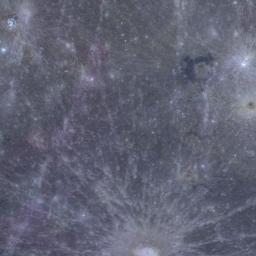
|
The New Three-Color Mosaic
- Click the image above for a larger view
- Full-Res JPEG (4505 x 4500) (1.7 MB)
- Full-Res TIFF (4505 x 4500) (60.9 MB)
Caption:
A new color mosaic created from MESSENGER images is now available! This mosaic was part of a release on March 7, 2014 by NASA's Planetary Data System (PDS) . A portion of the new color mosaic is shown here; can you find the craters Debussy , Derain , Berkel , and Warhol in this view? Explore the full 3-color mosaic (and confirm the locations of these craters) in QuickMap .
The images for MDIS's high-resolution 3-color mosaic were acquired during MESSENGER's second year in orbit about Mercury. The 3-color mosaic was designed to complement the 8-color base map acquired during MESSENGER's primary mission. By imaging Mercury's surface in a subset of the color filters at the highest resolution possible, the 3-color mosaic is available at 332 meters/pixel,as compared to 665 meters/pixel for the 8-color mosaic.
Instrument:
Wide Angle Camera (WAC) of the Mercury Dual Imaging System (MDIS)
WAC filters:
9, 7, 6 (996, 748, 433 nanometers) in red, green, and blue
Center Latitude:
-14.9°
Center Longitude:
10.3° E
Resolution:
332 meters/pixel
Scale:
Derain has a diameter of 167 km (104 miles)
Projection:
simple cylindrical
Background Info:
The MESSENGER spacecraft is the first ever to orbit the planet Mercury, and the spacecraft's seven scientific instruments and radio science investigation are unraveling the history and evolution of the Solar System's innermost planet. MESSENGER acquired over 150,000 images and extensive other data sets. MESSENGER is capable of continuing orbital operations until early 2015.
For information regarding the use of images, see the MESSENGER image use policy .
Cataloging Keywords:
| Name | Value | Additional Values |
|---|---|---|
| Target | Mercury | |
| System | ||
| Target Type | Planet | |
| Mission | MESSENGER | |
| Instrument Host | MESSENGER | |
| Host Type | Orbiter | |
| Instrument | Mercury Dual Imaging System (MDIS) | |
| Detector | Wide Angle Camera (WAC) | |
| Extra Keywords | Color, Crater, Map, Radio | |
| Acquisition Date | ||
| Release Date | 2014-03-10 | |
| Date in Caption | 2014-03-07 | |
| Image Credit | NASA/Johns Hopkins University Applied Physics Laboratory/Carnegie Institution of Washington | |
| Source | photojournal.jpl.nasa.gov/catalog/PIA18108 | |
| Identifier | PIA18108 | |
